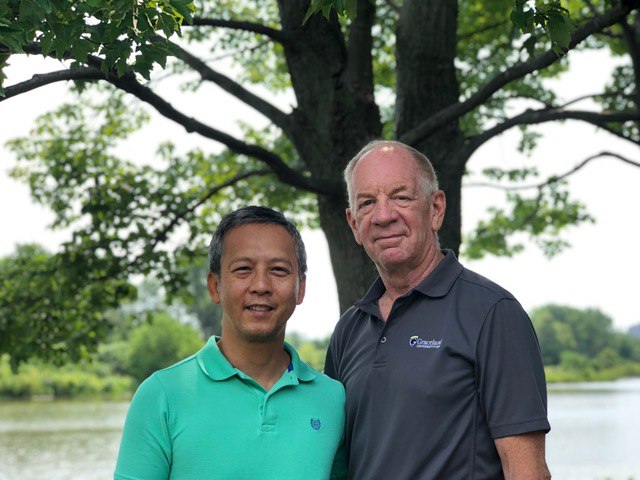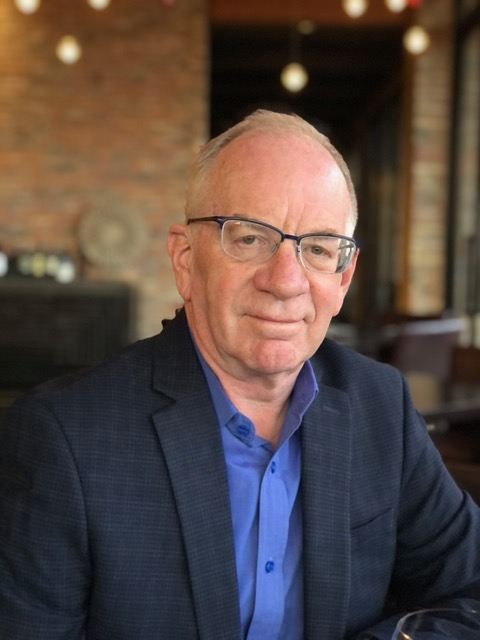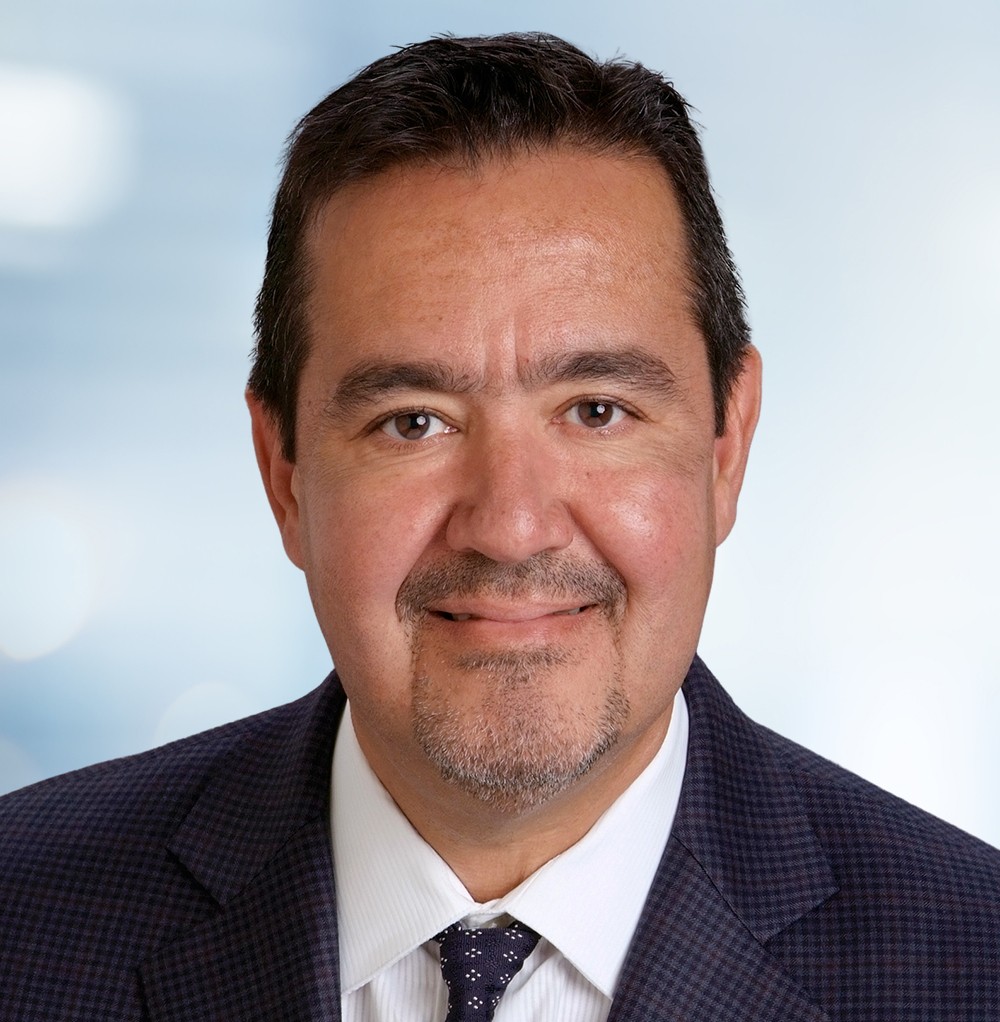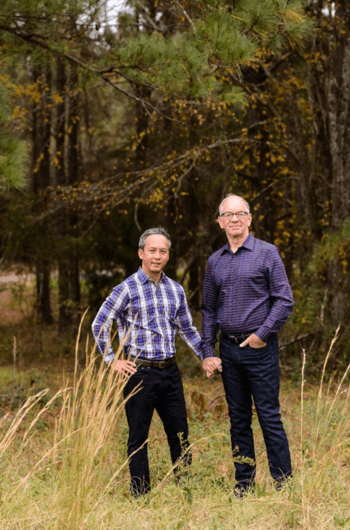
Endovascular Surgery Restores Function for Patient with Dural AV Fistula
Mark Barrett awoke in a haze. He looked around the room—cozy and bright, with daylight streaming in from behind him. He noticed a curtain pulled in front of the door and could sense that his husband was there.
“It reminded me of the resorts we’d visited in Southeast Asia,” he recalled. “I kept wondering what resort I was in.”
But Mark was in the Neuro-Intensive Care Unit at Barrow Neurological Institute in Phoenix. He’d just undergone endovascular surgery for a spinal dural arteriovenous fistula—a blood vessel abnormality in the outermost layer of the coverings of the spinal cord.
“I don’t know if that tells you that it was just a comfortable, vacation-like experience, or if I was still coming out of the anesthesia,” he laughed, “but I got really good care.”
It was Monday, May 24—four days after Mark arrived in the emergency department at St. Joseph’s Hospital and Medical Center, where Barrow is located.
Escalating Symptoms
Mark’s symptoms actually began in late January, with an acute urinary episode. He’d visited an emergency department at a different hospital, where a doctor diagnosed him with benign prostate hyperplasia (BPH)—a common condition in men around Mark’s age.
Mark, who is 68, followed up with a urologist and received a prescription for BPH medication. But his symptoms persisted.
Mark typically takes a two-hour walk every morning—often with his husband of nine years, Winston (Nguyenvu) Nguyen. The couple met while in a walking group in Chicago and moved to Phoenix five years ago, in part because the warmer weather suited their active lifestyle.
But Mark began to develop progressive imbalance and weakness in his legs, forcing him to cut his walk down to about 30 minutes at a time. So he made an appointment with his primary care physician.
Mark’s doctor took X-ray images, which didn’t indicate anything unusual. The doctor then ordered magnetic resonance imaging to get a more detailed picture.
Days before Mark’s scheduled MRI scan, his symptoms escalated. Mark was out for a walk on the morning of Thursday, May 20, while Winston was at work at Phoenix Children’s Hospital. He struggled to make it home and, by late afternoon, could hardly get around their house.
Mark called Winston, and they agreed he should seek emergency care. Having had a transient ischemic attack (TIA) while living in Chicago, Mark had been concerned about his neurological health. He opted to visit the emergency department at St. Joseph’s Hospital so that he’d have access to the neuroscience expertise at Barrow, if needed.
Dural AV Fistula Diagnosis: ‘A Lightbulb Moment’
After quickly ruling out a stroke, the emergency physician asked Mark if he had any numbness in his pelvic region. He told her “yes.”
“I think that was sort of a lightbulb moment for her—and probably for me too,” he recalled.
The doctor ordered an MRI, which revealed that a rare AV fistula —an abnormal connection of blood vessels—was compressing Mark’s spinal cord.
“In a five-hour timeframe, I went from being admitted into the emergency department and the neurosurgical floor, and then we had a diagnosis,” Mark said. “I just felt really assured that we were going to get a solution.”
Dural AV Fistula Treatment: Endovascular Neurosurgery
Mark met with Felipe Albuquerque, MD, the director of endovascular neurosurgery at Barrow, and learned that his AV fistula could be treated with a minimally invasive procedure called embolization.
This procedure would involve inserting a tiny catheter into a large blood vessel and navigating it through his network of blood vessels. Once the catheter reached the site of the fistula, Dr. Albuquerque would inject special materials to seal the lesion off from its blood supply so that it would no longer put pressure on the spinal cord.
Winston, a pediatric cardiac intensivist, mined through the scientific literature on Mark’s condition and found that Dr. Albuquerque had published his experiences with treating it.
“It was very important to us that we were with a team that had developed and fine-tuned this procedure,” Winston said.
The Barrow Difference
Mark and Winston felt reassured and comforted by their entire care team, including Dr. Albuquerque, their anesthesiologist, their operating room and bedside nurses, and the assisting residents and fellows.
“When you have a new diagnosis, especially for a rare condition, you can go down the rabbit hole thinking about worst possible scenarios,” Winston said. “From the minute we landed onto the (endovascular) floor, they helped reorient us and took good care of us.”
And it wasn’t just the medical team, Winston said. They felt cared for by every person with whom they interacted, from the environmental service technician who cleaned Mark’s room to the food service worker who delivered their meals.
“It’s not just the surgery that is impacting your experience and how you recover,” Winston said. “It’s all the parts—every hour of the day and every point of contact. Even the simple things, like the parking voucher, reduced the stress for us.”
‘Remarkable Progress’ Since Surgery
After Mark woke up from surgery, he met with Dr. Albuquerque again. The endovascular neurosurgeon told him that the procedure was a success and that Mark could expect a complete recovery.
“I am always amazed by the courage of patients,” Dr. Albuquerque said. “Mr. Barrett presented to us with progressive leg weakness, imbalance, and problems with bladder function. These severe symptoms are classic findings in patients with spinal dural arteriovenous fistulas.
“This is basically a short circuit between one of the arteries entering the spinal canal and the veins draining the spinal cord. This short circuit causes the blood pressure within the spinal cord to rise and causes swelling. Patients like Mr. Barrett often become progressively worse and can deteriorate to the point of complete paralysis and incontinence.
“In Mr. Barrett’s case, we were able to locate the short circuit and block it by injecting a liquid, glue-like substance directly into the site of the fistula. For him, this proved curative. Often patients take a bit of time to recover, and we’re thrilled to see the remarkable progress that Mr. Barrett has made.”
Mark was discharged from the hospital about 24 hours after surgery and underwent at-home physical therapy for the next four weeks. He is gradually rebuilding his strength at the gym.
“I feel very grateful that we’re living in a place where we have access to really superior health care and a facility like Barrow,” Mark said. “Dr. Albuquerque, and his team, really is, from what I understand, one of the best in the Valley—probably the best in the country—in terms of endovascular surgery.”
‘Our New Medical Home’
For Mark and Winston, the experience left them with a reminder to refocus on the important things in life: their time together and with other family and friends.
It also reminded them of the importance of advocating for your health care or that of a loved one.
“Sometimes you just have to push your medical team by asking: What else could be causing this? What other out-of-the-box diagnosis could be at play here?” Winston said. “You just have to ask those questions, especially when symptoms persist. In Mark’s case, that’s how we were able to get to the bottom of it—the initial diagnosis didn’t quite hit the mark.”
Mark is also thankful he decided to go to the emergency department a second time—especially the one at St. Joseph’s Hospital.
“If I hadn’t been in this place in the care of Dr. Albuquerque, with his expertise and skill, I might still be struggling to find out what’s wrong with me,” Mark said.
Their positive experience has motivated them to transfer all of their medical care to Barrow and St. Joseph’s.
While it may not be a vacation resort in Southeast Asia, “We’d like for it to be our new medical home,” Winston said.



